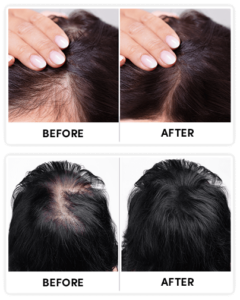Shedding or Permanent Loss? How to Tell What Your Hair Is Going Through

Getting to Grips with Hair Loss vs. Everyday Shedding
Hair loss and normal shedding can often seem like an unsolvable puzzle. Many of us find ourselves asking, "Am I really losing my hair, or is this just the usual shedding?" The first step to unraveling this mystery is to understand the difference between the two. Let's break it down and clear up any confusion.
What Does Normal Hair Shedding Look Like?
Losing hair on a daily basis is a natural part of the hair growth process. Typically, people shed between 50 to 100 hairs a day. That might sound like a lot, but with roughly 100,000 hair follicles on your scalp, it's just a tiny fraction. Shedding is how old hairs make way for new ones, keeping your scalp in tip-top shape.
The Hair Growth Cycle Explained
Your hair grows in a cycle that includes three main phases: anagen, catagen, and telogen. Anagen is the growth phase, lasting anywhere from two to seven years. Next up is catagen, a brief transition period. Finally, there's telogen, the resting stage when hair eventually falls out. Knowing these phases helps us tell the difference between normal shedding and more serious hair loss.
Spotting the Difference: Shedding vs. Hair Loss
Shedding generally means losing hair evenly across your scalp. In contrast, hair loss can follow specific patterns or lead to noticeable thinning or bald patches. If you find clumps of hair on your brush or notice more hair falling out than usual, it might be time to think about whether there's more than just shedding going on.
Is Your Hair Loss Here to Stay?
Figuring out if your hair loss is temporary or something more permanent can be tricky. However, there are tell-tale signs that can help you get to the root of what's happening with your hair.
Keeping Tabs on Hair Loss
If you're spotting more hair on your pillow or in the shower drain than usual, it's worth keeping an eye on. Track how much hair you're losing over time. A sudden spike in hair loss might be a warning sign of a more permanent issue.
Recognizing Permanent Hair Loss Patterns
Permanent hair loss often follows familiar patterns, particularly in cases like male or female pattern baldness. Men may see a receding hairline or thinning at the crown, while women might notice a widening part. Catching these patterns early can be crucial for managing permanent hair loss effectively.
When to Call in the Experts
If you're unsure about the nature of your hair loss, it's a good idea to see a specialist. Dermatologists or trichologists can offer insights and suggest treatments that fit your specific needs. Early intervention can make all the difference in saving your hair.
Why The Ancient Samurai Warriors Never Lost Their Hair…

guaranteed to work for any men or women out there...
Learn moreSigns Your Hair Loss Might Be Permanent
Permanent hair loss can appear in various ways, and spotting these signs early can help you seek the right treatment in time.
Spotting Bald Patches and Thinning Hair
One of the most obvious signs of permanent hair loss is the appearance of bald spots or noticeable thinning in certain areas. These areas often resist regrowth, signaling the need for professional evaluation and possible treatment.
Noticing Changes in Hair Texture and Quality
Permanent hair loss might also come with changes in your hair's texture or quality. You might find that your hair becomes finer, more brittle, or loses its volume over time. These changes can indicate an underlying issue that needs attention.
The Influence of Family History on Hair Loss
Your genes can have a big say in permanent hair loss. If baldness or thinning hair runs in your family, you might face similar issues. Being aware of your family history can help you prepare for and manage potential hair loss better.
What Causes Permanent Hair Loss?
Getting to the bottom of what causes permanent hair loss can shine a light on prevention and treatment options. Here are some common culprits.
The Role of Genetics and Hereditary Conditions
Genetics is a major player in permanent hair loss. Conditions like androgenetic alopecia, or male and female pattern baldness, are inherited traits. If your parents or grandparents dealt with hair loss, there's a good chance you might too.
How Medical Conditions Impact Hair
Certain medical conditions, such as autoimmune diseases like alopecia areata or hormonal imbalances like thyroid disorders, can lead to permanent hair loss. Managing these conditions often requires medical intervention to mitigate their effects on your hair.
Lifestyle Choices and Environmental Factors
Lifestyle choices, stress, and environmental factors can also contribute to hair loss. A poor diet, excessive styling, and exposure to pollutants or harsh chemicals can weaken hair and speed up loss. Tackling these factors can help reduce their impact.
Watch Your Hair Come Back FASTER Than You EVER Dreamed Possible

WITHOUT Expensive Medications, Lasers, or Painful Surgeries!
Watch free special videoDiagnosing Hair Loss: What Involves?
Understanding your hair loss involves a mix of self-assessment, consultations with professionals, and possibly some tests.
Starting with a Self-assessment
Before reaching out to a professional, you can begin with a simple self-assessment. Keep an eye on any changes in your hair's thickness, texture, or shedding patterns. Maintaining a hair diary can help track these changes and provide useful info to your doctor.
Seeking Advice from a Specialist
If your self-assessment raises concerns, it's time to see a dermatologist or trichologist. These experts can take a close look at your scalp, identify the potential causes of hair loss, and suggest suitable treatments.
Undergoing Laboratory Tests and Scalp Biopsies
In some situations, your doctor might recommend lab tests or a scalp biopsy to get a detailed view of your hair follicles. These tests can help pinpoint underlying conditions or confirm a diagnosis, guiding your treatment plan.
Options for Treating Permanent Hair Loss
Although permanent hair loss can be worrying, several treatment options can help manage and restore hair.
Medical Treatments and Medications
Medications like minoxidil and finasteride have shown effectiveness in slowing down or reversing hair loss in some cases. These treatments need a prescription and should be used under a healthcare professional's guidance.
Considering Surgical Solutions: Hair Transplants
For a more lasting solution, hair transplants can deliver impressive results. This surgical procedure involves moving hair follicles from one part of the scalp to another, effectively restoring hair in thinning or bald areas.
Exploring Alternative and Natural Remedies
Some folks prefer natural remedies or alternative treatments for hair loss. Options like essential oils, acupuncture, or herbal supplements might offer benefits, but it's crucial to approach these methods with caution and consult a pro before diving in.
Top Trichologist: Do This To Your Scalp To Regrow A Full Head Of Hair

Completely natural and dirt cheap way that makes it possible for you to finally regrow all your hair back.
Watch nowPreventing Hair Loss: Tips to Keep in Mind
Prevention is always better than cure. Here are some tips to help maintain your hair's health and ward off further loss.
Eating a Balanced Diet and Leading a Healthy Lifestyle
A diet packed with vitamins and minerals is vital for healthy hair. Include foods rich in protein, iron, and omega-3 fatty acids, which bolster hair growth and strength. Combined with regular exercise and enough sleep, these habits contribute to overall hair health.
The Importance of Stress Management
Chronic stress can worsen hair loss, so finding ways to manage stress is crucial. Techniques like yoga, meditation, or deep breathing exercises can help lower stress levels and promote a healthy scalp environment.
Adopting Proper Hair Care Practices
Gentle hair care practices can prevent hair loss. Steer clear of excessive heat styling, harsh chemical treatments, and tight hairstyles that tug at your hair. Use mild shampoos and conditioners to keep your scalp clean and nourished.
Knowing When to Seek Professional Help
If you're dealing with significant or worrying hair loss, getting professional help is essential for effective management.
Identifying Signs of Concerning Hair Loss
Recognizing when hair loss becomes a concern is key to seeking timely help. If your hair loss is sudden, patchy, or comes with other symptoms like itching or pain, it's time to see a specialist.
Finding the Right Expert for Your Needs
Choosing the right healthcare professional is crucial for tackling hair loss effectively. Dermatologists, trichologists, and endocrinologists can provide specialized insights and tailored treatment plans based on your unique needs.
Preparing for Your Appointment: What to Bring
Before your consultation, gather relevant information, such as your medical history, family history of hair loss, and notes from your hair diary. This info will help your specialist offer a comprehensive evaluation and create an effective treatment plan.
In conclusion, grasping the nuances between normal shedding and permanent hair loss is key to keeping your hair healthy. By staying informed and seeking expert advice when necessary, you can take proactive steps to protect and restore your hair's natural beauty.






